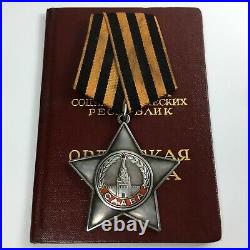
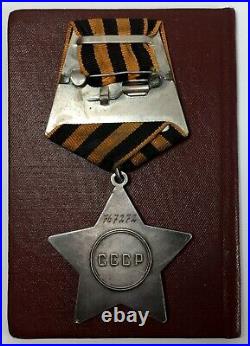
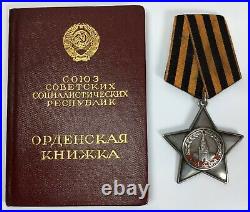
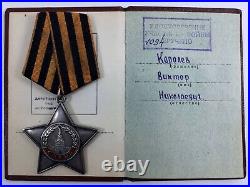

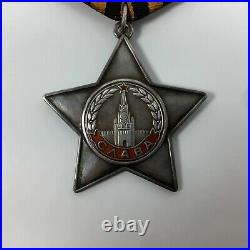
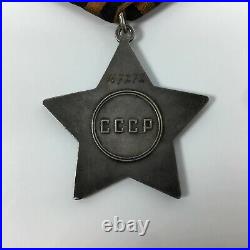
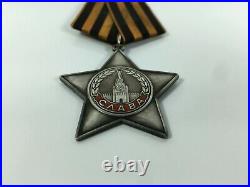
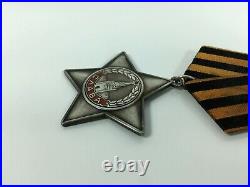
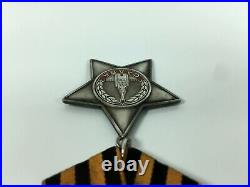
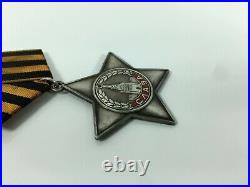
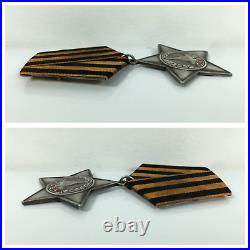

Real vintage silver order of glory 3 degrees of world war II from the USSR. Weight 22.260±1.6 g. The award was established by the decree of the Presidium of the Supreme Soviet of November 8, 1943. Subsequently, The Statute of the order was partially changed by Decrees of the Presidium of the Supreme Council of February 26 and December 16, 1947 and August 8, 1957. Statute of the order. The order of Glory is awarded to private and non-commissioned officers of the red Army, and in aviation and persons with the rank of second Lieutenant, who showed in the battles for the Soviet Homeland glorious feats of bravery, courage and fearlessness. The order of Glory consists of three degrees: I, II and III degrees. The highest degree of the order is the I degree. The award is made sequentially: first the third, then the second, and finally the first degree. The order of Glory is awarded for. Breaking first into the enemy’s position, personal bravery contributed to the success of the common cause. While in the tank that caught fire, he continued to perform a combat task. In a moment of danger saved the banner of his unit from capture by the enemy. From personal weapons accurate shooting destroyed from 10 to 50 soldiers and officers of the enemy. In the battle, the fire of an anti-tank gun disabled at least two enemy tanks. Destroyed with hand grenades on the battlefield or behind enemy lines from one to three tanks. Destroyed by artillery or machine gun fire at least three enemy aircraft. Despising the danger of the first broke into the BUNKER (pillbox, trench or dugout) of the enemy, decisively destroyed its garrison. As a result of personal reconnaissance, I identified the weak points of the enemy’s defense and brought our troops to the enemy’s rear. Personally captured an enemy officer. At night, he removed the guard post (watch, secret) of the enemy or captured it. Personally, with resourcefulness and courage, I made my way to the enemy’s position and destroyed his machine gun or mortar. Being in a night sortie, destroyed the enemy’s warehouse with military equipment. Risking his life, he saved the commander in battle from the immediate danger that threatened him. Disregarding personal danger, in battle captured the enemy’s banner. From personal weapons shot down an enemy plane. By destroying the enemy’s firepower with artillery or mortar fire, he ensured the successful actions of his unit. Under enemy fire, he made a pass through the enemy’s wire barriers for the advancing unit. Risking his life, under enemy fire, he provided assistance to the wounded during a number of battles. Being in a damaged tank, he continued to perform a combat task using the tank’s weapons. Rapidly crashing his tank into the enemy column, crushed it and continued to perform the combat task. His tank crushed one or more enemy guns or destroyed at least two machine gun nests. While in intelligence, I got valuable information about the enemy. A fighter pilot destroyed two to four enemy fighter planes or three to six bomber planes in aerial combat. As a result of an assault RAID, an attack pilot destroyed from two to five enemy tanks or from three to six locomotives, or blew up a train at a railway station or stage, or destroyed at least two aircraft at an enemy airfield. The attack pilot destroyed one or two enemy aircraft as a result of bold initiative actions in air combat. The crew of the day bomber destroyed a railway train, blew up a bridge, ammunition depot, fuel, destroyed the headquarters of any enemy unit, destroyed a railway station or stage, blew up a power plant, blew up a dam, destroyed a military vessel, transport, boat, destroyed at least two aircraft at the enemy airfield. The crew of a light night bomber blew up an ammunition and fuel depot, destroyed the enemy headquarters, blew up a railway train, and blew up a bridge. The crew of a long-range night bomber destroyed a railway station, blew up an ammunition or fuel depot, destroyed a port facility, destroyed a sea transport or railway train, destroyed or burned an important factory or factory. Day bomber crew for daring action in aerial combat, resulting in the Downing of one to two aircraft. The scout crew for successfully completed reconnaissance, which resulted in valuable data about the enemy. The award of the order of Glory is made by decree of the Presidium of the Supreme Soviet of the USSR. Recipients of the order of Glory of all three degrees are awarded the right to confer military rank. Privates, corporal and Sergeant-major. Having the rank of petty officer-second Lieutenant. Second lieutenants in aviation-Lieutenant. The order of Glory worn on the left side of the chest and when other medals of the USSR placed after the order Sign of Honor order of precedence degrees. Description of the order. The badge of the order of Glory is a five-pointed star measuring 46 mm between opposite vertexes. The surface of the star’s rays is slightly convex. On the front side in the middle part of the star is a circle-medallion with a diameter of 23.5 mm with a relief image of the Kremlin with the Spasskaya tower in the center. Around the medallion’s circumference is a Laurel wreath. In the lower part of the circle is a convex inscription GLORY on a red enamel ribbon. On the reverse side of the order – a circle with a diameter of 19 mm with a relief inscription in the middle “USSR”. On the edge of the star and the circle on the front side – convex sides. The badge of the order of the first degree is made of gold (sample 950). Gold content in the order of the first degree – 28.619±1.425 g. The total weight of the order is 30.414±1.5 g. The badge of the order of the II degree is made of silver, and the circle with the image of the Kremlin with the Spasskaya tower is gilded. Silver content in the order of the II degree – 20,302±1,222 g. The total weight of the order is 22.024±1.5 g. The badge of the order of the III degree is silver, without gilding in the Central circle. Silver content in the order of the III degree – 20,549±1,388 g. The total weight of the order is 22.260±1.6 g. The sign is connected by means of an eyelet and a ring to a pentagonal pad covered with a 24 mm wide silk moire ribbon. The ribbon has five longitudinal equal-width alternating stripes: three black and two orange. At the edges of the tape has one narrow orange strip 1 mm wide. History of the order. The order of Glory was established on the same day as the order of Victory. It became the last of the “land” orders created during the war: after it appeared only the sea orders of Ushakov and Nakhimov. The order had several features that no other national award had. First, this is the only combat distinction designed to award exclusively to soldiers and sergeants (in aviation, also second lieutenants). Secondly, they were awarded only in ascending order, starting with the Junior-III degree. This order was repeated only thirty years later in the statutes of the orders of Labor Glory and for service to the Motherland In the armed Forces of the USSR. Third, the order of Glory until 1974 was the only order of the USSR issued only for personal merit and never issued to military units, enterprises, or organizations. Fourth, the Statute of the order provided for the promotion of all three degrees of rank, which was an exception to the Soviet award system. Fifth, the colors of the ribbon of the order of Glory repeat the colors of the ribbon of the Russian Imperial order of St. George, which in Stalin’s time was at least unexpected. Sixth, the color and pattern of the ribbon were the same for all three degrees, which was typical only for the pre-revolutionary award system, but was never used in the award system of the USSR. The order was established on the initiative of Stalin I. The first proposal for its establishment was made on June 20, 1943, during the discussion of the draft order “Victory” at a meeting of the people’s Commissariat of defense. The technical Committee Of the main Quartermaster Department of the red Army, which was headed by Lieutenant General AGINSKY S. Was assigned to develop a draft of this order in August 1943. Nine artists worked on the order’s sketches. On October 2, 1943, out of 26 projects created by artists, 4 were presented to Stalin, who chose a drawing by N. (author of projects of the order of Kutuzov, the medal partisan of the Patriotic war and all medals for the defense of cities of the USSR). According to the plan, the order was to have 4 degrees: the same as the order of St. George and the badge of distinction of the military order – the famous George cross. It was originally planned to call it the order of Bagration. Stalin approved the colors of the ribbon, but ordered to reduce the number of degrees to three, similar to “military orders, and call the award the order of Glory, explaining that” victory without glory does not happen. On October 11, 1943, the revised drawings were submitted to the NCO and approved on October 23. The right of awarding the order of Glory III degree was given to the commanders of formations from the brigade commander and higher, the order of Glory II degree – from the commander of the army (flotilla), and I degree of order could only reward the Presidium of the Supreme Soviet of the USSR. From February 26, 1947, the right to award any degree of the order passed exclusively to the Supreme Soviet of the USSR. The first reliably established representation for the order of Glory was held on 13 November 1943 when he was signed award list of presenting the order of the III degree sapper staff Sergeant Malyshev V. During the battle, Vasily Malyshev made his way to the enemy machine guns, preventing the advance of our troops, and destroyed it. Earned another order of Glory-II degree. Some sources give information that the first order of Glory of the III degree was awarded to sapper Sergeant Israelyan G. 52 for the 182nd rifle division dated November 17, 1943. Most likely, Malyshev was first presented to the order, but was awarded the order later, when Israelyan was already awarded. Since the orders were sent to different sections of the front in parties and distributed among the headquarters of formations entitled to award, the order issued earlier often had a larger number than the order issued later. Thus, the first batch of orders of the first degree was sent to the Leningrad front, and the first batch of orders of the third degree was sent to the 2nd Ukrainian front. Therefore, the order of Glory of the III degree No. 1 was later awarded to the 2nd Ukrainian front’s armored truck driver, senior Sergeant I. The first recipients of the order of Glory of the II degree were sappers of the 10th army of the Western (1st Belorussian) front, privates S. 634 for the troops of the 10th army of December 10, 1943. By the end of the war, Baranov and Vlasov received the first degree of the order. The first award of the order of Glory of the highest, I degree took place in July 1944. The first full recipients of the order of Glory were assistant platoon commander senior Sergeant Shevchenko K. Badge of the order No. 21 and sapper corporal Pitenin M. (Decree of the Presidium of the Supreme Soviet of the USSR of July 22, 1944). Pitenin died before the Decree was signed, before he received the order. Shevchenko reached the end of the war, also having the order of the red banner, the Patriotic war and the red Star, which was very rare for a Sergeant. The addition to his three orders of all three degrees of the order of Glory made him a phenomenon: not every Colonel or even General had six orders. A soldier of the 63rd Guards rifle division of the Leningrad front, commander of the infantry division of the guard, senior Sergeant Nikolai Zaletov (Decree of the Presidium of the Supreme Soviet of the USSR dated October 5, 1944) received the badge of the order of Glory of the first degree No. During the assault on the Karelian rampart, the company commander was killed, and, taking command, N. Zaletov, at the head of the company, was the first to break into the enemy stronghold. Zaletov owned the order of Glory of the II degree # 404 and III degree # 13789. The badge of the order of Glory of the first degree No. 2 was received by a soldier of the same 63rd Guards rifle division, Sergeant-major V. Ivanov (Decree of the Presidium of the Supreme Soviet of the USSR dated March 24, 1945). The first Decrees of the Soviet PVA on awarding orders of Glory of the III and II degrees were issued on December 21, 1943 (16 soldiers of the 1st separate Czechoslovak brigade) and may 15, 1946 sergeants S. Since in difficult front-line conditions there could be confusion in the documents for submission to the award, there are cases of repeated awarding of the same degree of the order (usually the third). For example, Vasily Timofeyevich Khristenko was awarded two orders of Glory of the III degree (February 22, 1944 and November 4, 1944), and later became a full knight, also receiving the order of Glory of the II degree (January 24, 1945) and the order of Glory of the I degree (may 15, 1946). In addition to four orders of Glory, during the war Khristenko was awarded the order of the red Star and the Patriotic war. After the war, he was awarded the orders of Lenin, the October Revolution, the red banner of Labor, and the Badge of Honor for his labor exploits. Scout of the 128th mountain rifle division Alimurat Gaibov became a full knight of the order of Glory, but he was awarded the second degree of the order twice. In addition to Gaibov, two other full Cavaliers had four orders of Glory due to the erroneous re-awarding of the second degree – gunner of the 1071st fighter-anti-tank artillery regiment Vasily Naldin and scout of the 35th guards rifle division of the guard petty officer Alexey Petrukovich. Hero of the Soviet Union Sergeant Glazkov V. Was awarded two orders of Glory of the 3rd degree. In the Soviet Army there was a unit, all the soldiers of which (except officers) were awarded the order of Glory. We are talking about the 1st battalion of the 215th red banner regiment of the 77th guards Chernihiv red banner order of Lenin and Suvorov rifle division of the 69th army of the 1st Belorussian front. During the liberation of Poland, during the breakthrough of the deep-echeloned German defense on the left Bank of the Vistula on January 14, 1945, the soldiers of this battalion quickly captured three lines of enemy trenches and held the position until the main forces approached. Soldier of the guard battalion senior Sergeant I. Perov he closed the embrasure of the enemy Pillbox with his chest, repeating the feat of Alexander Matrosov. All soldiers, sergeants and petty officers of the battalion became recipients of the order of Glory. Platoon commanders were awarded the order of Alexander Nevsky, and company commanders were awarded the order of the red banner. The battalion commander of the 23-year-old guards major Yemelyanov B. (posthumously) became Heroes of the Soviet Union. Among more than two and a half thousand full holders of the order of Glory, four bear the title of Hero of the Soviet Union. Gunner of the guard senior Sergeant Aleshin A. Pilot-stormtrooper second Lieutenant of aviation Drachenko I. Marine guard petty officer Dubinda P. Gunner senior Sergeant Kuznetsov N. (received the order of the first degree only in 1980). The title of Hero of the Soviet Union is also held by 80 knights of the order of Glory II degree and 647 knights of the order of Glory III degree. Among the full recipients of the order of Glory, there are four women. Sniper petty officer N. Petrova killed in action on may 1, 1945, born in 1893! Machine gunner of the 16th Lithuanian division, Sergeant Staniliene D. Nurse foreman Nozdracheva M. Air gunner-radio operator of the 99th separate Guards reconnaissance aviation regiment of the 15th air army of the guard, Sergeant Zhurkina N. Eight full recipients of the order of Glory in the postwar years were awarded the title Hero of Socialist Labor: Velichko M. There are cases of awarding four orders of Glory. Among the four order-bearers A. Gaibov (two orders of the II degree), V. In the ranks of the red Army fought a soldier Kuzin S. A knight of two George crosses, during the great Patriotic war, also awarded two orders of Glory. According to some sources, the order of Glory was also awarded to soldiers of the allied armies. So, on the website of the American collector Paul Schmitt, I found information that the order of Glory of the III degree was awarded to a soldier of the US Navy Cecil R. Probably, the American knight of Glory could be part of one of the sea convoys. This product is very old and has signs of aging. In case of unforeseen circumstances, do not rush to open a dispute, write to me, and I will begin to solve the problem. If you have any complaints, questions or concerns, I will be happy to answer them. The most valuable thing for me is your opinion and satisfaction, my reputation is also very important for me. Thank you for your understanding, waiting for your feedback! The item “Order of Glory 3rd class award WW II medal ribbons Silver pin military ORIGINAL” is in sale since Sunday, March 14, 2021. This item is in the category “Collectibles\Militaria\WW II (1939-45)\Original Period Items\Russia\Medals, Pins & Ribbons”. The seller is “sagulatus” and is located in Irpin. This item can be shipped worldwide.
- Region of Origin: Russia
- Featured Refinements: Order
- Modified Item: No
- Country/Region of Manufacture: Russian Federation
- Theme: Militaria
- Original/Reproduction: Original
- Material: Sterling silver enamel
- Made in the: USSR
- Type: Medal
- Conflict: WW II (1939-45)

